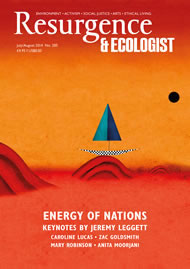Many environmental changes on our planet resulting from human activity are not well understood.
The sensitivity of the global climate to rapid increases in greenhouse-gas concentrations is unknown, though recent studies strongly suggest it is likely to be towards the upper end of the predicted range. At least two changes have come as almost complete surprises. Scientists did not anticipate the stratospheric ozone hole, which was discovered in the 1980s and – fortunately – has so far proven to be a relatively straightforward challenge to address. Ocean acidification, which may be proceeding at a rate outstripping anything in the Earth’s history, only came into focus around a dozen years ago, and looks to be far more intractable.
In so far as it is possible to constrain the uncertainties and anticipate surprises, however, some of the consequences of these changes that are under way look very grim. The Earth is losing species at between one and ten thousand times the background rate – the slow natural ‘churn’ in the very long periods between five brief mass extinction events in the history of complex life. It looks likely that as many as half of the plants and animals with whom we share the planet will be extinct by 2050.
The enormity of this crisis almost repels thought. But not quite. Courageous figures in the spiritual traditions, not to mention conservationists, activists and others, struggle to raise awareness and find solutions or at least mitigate the worst effects, seeking to create space for resilience and hope. Among many remarkable artistic responses and interventions is Maya Lin’s What is Missing?, a project with no defined end, which allows people anywhere to appreciate the past as well as imagine possible futures.
Numerous journalists and popular science writers have also produced excellent work to help us get our heads around the scale of the crisis. The Sixth Extinction, by Elizabeth Kolbert, is a welcome addition to this company. It offers well-composed snapshots of history, theory and observation that will fascinate, enlighten and appal many readers.
Kolbert begins in medias res with a visit to a field station in Costa Rica where researchers are documenting the disappearance of the golden frog, Atelopus zeteki. Amphibians, the class that includes the frogs, are the most endangered group of animals in the world, with an extinction rate as much as 45,000 times background. In addition to factors such as habitat loss, a kind of chytrid fungus inadvertently spread by humans and lethal to many amphibians is thought to be to blame.
Kolbert then outlines the development of extinction as an idea and how it has changed our view of life, before providing vivid reportage from the field – with a focus on the impacts of ocean acidificiation, the fate of coral reefs, the rapid transformation of tropical forests, the consequences of the rapid transference of species to new locations, and more.
Towards the end of the book, Kolbert writes: “We are deciding, without quite meaning to, which evolutionary pathways remain open and which don’t.” We need to decide otherwise. We need a lot more imaginative thinking about the choices we can make and what comes next, whether it be the Ecozoic imagined by the theologian Thomas Berry, the feral landscape of George Monbiot, or even a world utterly transformed by synthetic biology as envisaged by Craig Venter and others. We have long since left behind the “places of many generations” known to our Palaeolithic ancestors. We need new big stories. And it is not absurd to ask whether we can express our humanity by altering Earth with compassion for the other creatures, and in celebration of their endless forms.







